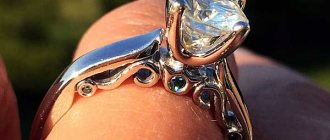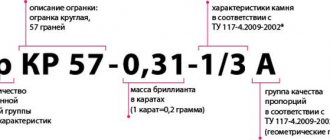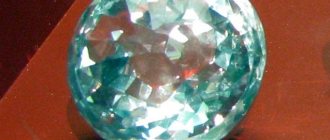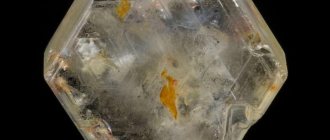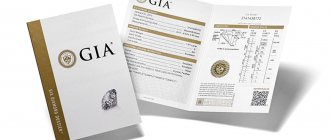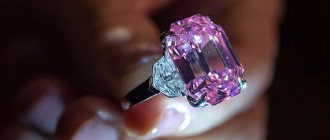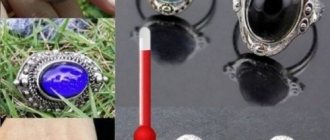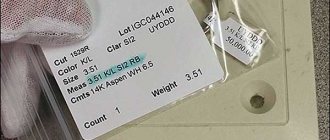When it comes to quality, diamonds are classified primarily by what is known as the 4Cs: color, clarity, cut and carat. These are the four characteristics that are considered the most important in determining how much a diamond is worth.
Besides the 4Cs, there are several other diamond features that are often included in the grading report: brilliance, symmetry, belt thickness and fluorescence, among others.
However, they do not affect the price of a diamond to the same extent as the 4Cs.
Next, we will look at the most important quality characteristics in diamond grading and take a closer look at the definitions of these characteristics.
Purity.
Diamond clarity, as its name suggests, refers to how clean the stone appears. All diamonds have some natural imperfections such as black spots, lines, surface imperfections, etc.
The smaller and less visible such imperfections are in the stone, the higher its grade of purity.
Low clarity diamonds have imperfections that are easily visible to the naked eye, while high clarity stones appear quite clean, even under magnification.
There is no place to put the sample
Amir is far from high fashion. His products are not shown on catwalks and are not offered to the richest people around the world. He creates his little masterpieces for ordinary people. Weddings, birthdays, anniversaries - he has gifts for every occasion and pocket. If you don’t know exactly where Amir’s store is, it will be difficult to find it, because the market where he works is very popular among tourists and is popularly nicknamed “Yashka”. There are so many jewelry shops here that it’s dizzying.
There is not much jewelry in the window of his small store, but as he talks with the client, more and more luxury items appear from his hidden bins. He has even more precious stones. Different shapes, different quality and prices. Many clients come specifically for stones and order jewelry to match them.
In India, do all jewelers do this, how do you do it? Do they put the worst things on display in the window, but keep the most interesting things in a case?
Amir:
No, it's just that the store is small and the display cases can't accommodate everything. Although we prefer not to display those more expensive products from a safety point of view.
How long has your family been in the jewelry business?
Amir:
The origins date back to the arrival of the Mughals in India (XVI century - Author). But that's how the family story goes. And so I can clearly say that for the last 300 years all my ancestors, including my father, grandfather, etc., were jewelers. Now I continue the business together with my brothers.
Are you from some special caste or did it just happen that way?
Amir:
Yes, our caste is Sheikh-Lahori. Everyone who belongs to it is engaged in jewelry making.
Please tell me what an ordinary person can do, i.e. not a jeweler, how to distinguish a good gemstone from a bad one?
Amir:
Firstly, if you are going to buy a stone or jewelry, always ask for a certificate. If the store is good, they will definitely present you with such a document. I have it for all products with precious stones. If it is not there and you still want to purchase jewelry, take a close look at the stone. Of course, this is not easy, but still, by holding it in the light, you can understand whether it is cloudy or transparent, whether there are chips and scratches, cracks, etc. The stone can also be weighed: real natural stone is always heavier than artificial stone.
Are there many artificial stones in the Indian market?
Amir:
Yes, there are often fakes, so you need to be more careful. Moreover, you can be deceived not only when buying cheap jewelry, you can spend several thousand dollars and be left with nothing. Therefore, choose a safe place.
What are “heated” stones?
Amir:
The stone is heated so that it matures faster and acquires a more saturated color. For example, all rubies sold in Delhi shops are “heated”. They are real, they will even give you a certificate for them, but they acquired their color artificially. There is a small proportion of Burmese rubies, they differ greatly from others in their dark red color and price. They are many times more expensive.
Another category of stones is “treated”. For example, there is a real natural stone, but it has one small flaw - emptiness inside. Then it is cleaned and filled with tinted liquid glass. It hardens and the stone is ready. He is also real, but with nuance.
Do Delhi shops sell products made from local stones or do you import them?
Amir:
Most of the stones are imported. Mostly African, and also brought from Southeast Asia. In India, stones are practically not mined.
But are there still stones about which we can confidently say that they are from India?
Amir:
There are Kashmir topazes and emeralds. They are of very high quality and very expensive. You can rarely find them on the market. But semi-precious stones such as garnet, moonstone, black onyx, cat's eye are produced mainly in India.
Is it possible to determine the value of a stone by its cut?
Amir:
The arithmetic is simple: the fewer faces, the cheaper the stone. For a diamond, for example, the maximum number of facets is 57. Such a stone will be expensive. Other stones also have their own cutting methods, since they all differ in their physical qualities. But this task can only be done by a specialist. It will be difficult for an ordinary person to immediately determine the type of cut, and he is unlikely to count the edges. (Laughs.)
What stones are in fashion today?
Amir:
Of course, diamonds. They are always in fashion. For example, all our diamonds are African. Sapphires and rubies are also popular. Among semi-precious stones, blue topaz comes first.
Do you have Russian diamonds? A lot of diamonds are mined here in Yakutia...
Amir: No, maybe they will appear in the future.
What stones do you recommend buying in India?
Amir:
High quality. (Laughs.)
What can you say about pearls?
Amir:
All freshwater pearls are from China. Seaborne is rare, it is much more expensive and is usually brought to order.
Tell us about gold alloys... Which ones are used for jewelry in India?
Amir:
We add copper and silver to gold, so Indian gold is softer and easier to work.
Are you doing tests?
Amir:
A government hallmark is required for gold items. It is applied with a laser and, in addition to the purity of the metal, the symbol of the company where the product was produced is also applied. Our symbol is a star. Other stores have their own symbols. Using it you can find out the history of jewelry according to the state register, where all jewelry companies are noted. Large ones, of course. If there is no such test, then it is better to think about whether to buy jewelry. But I put my own hallmark on silver items so as not to pay duty to the state. Silver is not very expensive, and it turns out to be unprofitable to pay extra for the sample.
Do you also make silver items?
Amir:
Yes, but not very much.
Are they also counterfeited or is it unprofitable?
Amir:
Yes, sure. We need to be more careful. Sometimes they can sell you a silver table set with only 50% silver, but they will charge you for the 875th standard. Here it is advisable to buy one spoon from the set and take it to the laboratory for analysis. But it will take 1-2 days. Therefore there is another way. If the spoon bends and does not break, it means there is a lot of silver in the product and the standard is high, and if it breaks, it means it is mixed in half with another metal.
Is it true that to smooth out imperfections in jewelry, they are coated with rhodium?
Amir:
A layer of rhodium is usually applied to gold and silver jewelry not only to hide flaws in the jeweler's work, but also to add shine to the jewelry. There is nothing wrong with this, but you need to remember that some people are allergic to it.
How can you check a product for the presence of rhodium?
Amir:
Such products are immediately noticeable. They have an unnaturally bright shine. They don't fade. You also need to remember that a fake may be hidden behind the rhodium layer. So they may slip you, for example, a copper or bronze ring instead of a gold one, and you will only find out about it a year later, when the rhodium layer is gradually erased.
You have been in the jewelry business for many years, who are your customers?
Amir:
Our market is mainly visited by tourists from Russia and CIS countries. I even learned a little Russian specifically for them.
Cut.
Diamond cut is another extremely important quality characteristic.
Generally, cut refers to the number, position and shape of a stone's facets, and the quality of the cut is related to how proportional the key parts of the diamond are relative to each other. This proportionality is usually measured by calculating a ratio based on the width, length, depth, or diameter of the diamond.
Certain cut proportions result in improved light reflection of the diamond, maximizing its brilliance. In general, the closer a diamond's measurements are to these proportions, the higher the quality of its cut is rated.
The most reliable standards in existence are those developed for the round cut, while grading scales for other cuts are not as well known.
Carat.
Carat weight is a measure of how much a diamond weighs, and 1 carat is equal to 200 milligrams.
Although carat is not a characteristic that affects a diamond's appearance in the same way as color, clarity, and cut, it is an important factor in diamond grading.
In general, larger diamonds are more expensive not only in terms of overall cost, but also in terms of price per carat. This makes sense - after all, larger diamonds are much rarer and that's why they fetch higher prices.
Fluorescence.
Diamond fluorescence is the ability of a diamond to emit light and change color when exposed to ultraviolet rays.
For example, if you go to a nightclub and there is ultraviolet light, your diamond may start to glow blue.
Diamond reports usually include information about whether the stone shows fluorescence, as well as how strong it is.
It's worth noting that not all diamonds fluoresce, and those that can fluoresce vary in the intensity of the light they emit. Approximately one third of all diamonds that are graded show some fluorescence.
The reason for diamond fluorescence is hidden within. Diamonds contain various chemical elements that, depending on their concentration, can glow in the dark.
They can fluoresce in a variety of colors such as yellow, red and green, but the most common color is blue. Non-blue fluorescence is extremely rare.
How does fluorescence affect the quality of a diamond?
Whether a diamond is fluorescent and what color it will glow is usually listed on its grading report. The effect of fluorescence on its quality, however, is a controversial topic. The GIA (Gemological Institute of America) conducted a study on fluorescence and concluded that whether a stone is fluorescent has no effect on how the average observer perceives its quality.
It's also worth noting that the experts involved in the study couldn't agree on whether fluorescence had a significant effect on a diamond's appearance. There are jewelers who claim that in their experience, stones that show strong fluorescence also tend to appear more hazy.
Conclusion: You must decide for yourself whether a particular diamond looks good to you, regardless of fluorescence. If you think it looks a little hazy, choose another one. Don't let fluorescence alone sway your decision without looking at the stone as a whole.
Fluorescence and prices a.
Because strong fluorescence is considered a negative characteristic by some, these stones can command lower prices compared to similar graded non-fluorescent diamonds. So if you see a fluorescent diamond, check to see if it's a good buy - if you like its colour, clarity and cut, you could save some money.
Some people believe that for low color grade diamonds, those that have yellowish undertones, blue fluorescence can actually improve their appearance by masking the yellow color. Again, only you can decide whether this will be true in each case.
Stones with yellow fluorescence are typically rated lower because yellow tints are thought to reduce the quality of the diamond's color.
Phosphorescence.
Once a fluorescent diamond is no longer exposed to ultraviolet light, it can continue to glow for a while. This is a rare property called phosphorescence.
When purchasing, ask to see the stone under ultraviolet and normal lighting. You should know how it will look in different conditions before you make a decision.
Be sure to look at it in daylight. Remember that sunlight contains ultraviolet rays which will bring out the fluorescent colors of your stone when it is sunny.
Stones showing yellow fluorescence will appear yellow whenever ultraviolet rays are present, including in daylight.
Keep this in mind if you want nothing to do with yellow when it comes to diamonds.
If the diamond is fluorescent, compare it to a non-fluorescent stone of similar quality to judge if you see any difference in color or clarity.
Synthetic diamonds do not fluoresce, so if a stone fluoresces, it is undoubtedly a real diamond; however, keep in mind that approximately two-thirds of real diamonds do not show fluorescence.
The problem with artificial diamonds
The three largest international organizations involved in the sale, purchase and processing of diamonds: IDMA (International Diamond Manufacturers Association), WFDB (World Federation of Diamond Bourses) and CIBJO (World Jewelry Confederation) approved a joint statement in the spring of 2008, which marked the beginning of the creation of a market dedicated to for the legal circulation of artificially produced diamonds.
The three largest international organizations involved in the sale, purchase and processing of diamonds: IDMA (International Diamond Manufacturers Association), WFDB (World Federation of Diamond Bourses) and CIBJO (World Jewelry Confederation) approved a joint statement in the spring of 2008, which marked the beginning of the creation of a market dedicated to for the legal circulation of artificially produced diamonds.
The text of the statement specifies some of the terms used. Now, diamonds suitable for jewelry cutting, if they are created in a laboratory or factory, will be called “man-made”, “lab-created”, “lab-grown” or “synthetic”. For artificial diamonds suitable for jewelry processing, the term “cultured” should never be used. A reference book popular among jewelers, most often called the “Diamond Blue Book,” allows only one definition for such diamonds: “synthetic.”
Moreover, if a natural diamond (diamond) has been technologically refined, it cannot be classified as either synthetic or natural (natural) diamonds.
Thus, the application legalizes three types of diamonds:
- synthetic;
- ennobled;
- natural;
In Russia today there is no market for the legal circulation of synthetic diamonds, although experts have pointed to isolated cases of artificial diamonds appearing in our country, including in the form of individual stones and as an element of jewelry . Synthetic diamonds were sold for several thousand dollars per carat, a price similar to that of high quality natural diamonds.
As Yuri Shelementyev, head of the Gemological Center of Moscow State University, said, now almost no one remembers synthetic diamonds. Most likely, the foreign production of such stones did not pay off due to the low demand for synthetic diamonds. These stones generally do not resemble real diamonds, primarily due to their coloring.
Ararat Evoyan, vice-president of the Association of Russian Diamond Producers, believes that roughly the same thing will happen to diamonds as happened before with other artificial precious stones. There will certainly be buyers for such stones, and, unfortunately, there will also be crime associated with the trafficking of these stones.
Most likely, for now, synthetic diamonds only end up on the black or “gray” market. Moreover, it is difficult for artificial diamonds to compete with cheap analogues - cubic zirconia and rhinestones due to high prices. It is possible that there is also a psychological barrier: synthetic diamonds are perceived on the same level as silicone breasts or fake alcohol.
Meanwhile, the circulation of artificial diamonds has already been legalized on the market abroad. According to the Gemesis company (USA), its annual production of synthetic diamonds has already reached tens of thousands. It is characteristic that this company uses Russian BARS technology, which was created in Novosibirsk, in Akademgorodok. Some Russian technologists, for example, Boris Felgenson, helped the Americans build and launch the corresponding production line.
There are also smaller manufacturing operations in the US, examples being Apollo Diamond and Gems & Diamonds. A number of jewelry designers have already used artificial stones to create collections. One of them, “Astounding,” includes jewelry with pink and blue artificial diamonds. The products are advertised as environmentally friendly, which is pure nonsense from a technological and chemical point of view.
Sales are carried out mainly via the Internet. About 10 companies are engaged in this. For example, DiamondsCultured.com offers the purchase of Gemesis and Chatham diamonds and jewelry with such stones. The company offers to purchase yellow diamonds weighing up to 1.5 carats, pink or blue – up to 0.75 carats. Delivery time is 10 days. And the company D.NEA provides a price list for diamonds weighing 0.5 carats. The cheapest are orange diamonds, the price is about $1,000, the most expensive are blue diamonds - up to $3,000. In advertising of stones, the emphasis is on the “non-conflict” nature of synthetic stones.
Today there are no global statistics on the turnover of synthetic diamonds. But at first glance, all operations appear to take place in the United States, where consumers and sellers are equally sympathetic to the progress of technology.
It is not yet clear what awaits the market for synthetic diamonds and rough diamonds. Vladimir Zboikov, who runs the Elgem company, believes that China will rapidly develop the production of artificial diamonds, and a significant part of them will be sold under the guise of natural ones.
And Valery Morozov, head of Ruiz Diamond CJSC, is convinced that fears associated with synthetic stones are unfounded. Although such stones have been around for a long time, and their manufacturing technologies are constantly improving, the turnover of synthetic diamonds remains insignificant. Therefore, it makes more sense to create a cheap device that allows you to distinguish natural stone from synthetic one - and close the issue.
It follows that in the foreseeable future, jewelers are not in danger of losing any significant part of the diamond jewelry The most that both legal and “black” synthetic diamond traders can count on is one percent of the jewelry market. Meanwhile, despite the significant progress in scientific research in the field of carbon materials, the creation of equipment that will allow the synthesis of gem-quality diamonds in volumes that will cover the extraction of natural diamonds at a low cost of the synthesis process still remains an unattainable task.
Belt.
The belt of a diamond is its edge, or the widest part of the stone (in round cuts). The classification of a belt is usually a simple description of how thick or thin it is.
It is also the line that defines the boundaries between the top and bottom areas of the diamond. The part above the girdle is called the crown, and the part below is called the pavilion.
Why is the belt so important?
The belt plays an important role when measuring the proportions of a diamond. The remaining parts of the stone are compared to the girdle in terms of size, and this comparison is used to determine how well the stone is cut.
For example, the radius of a diamond's flat top (plate), crown height, pavilion depth, and overall diamond height are often expressed as a percentage of the girdle, which is a measure of the overall width of the stone.
So why do all these percentages matter? These are very important because they determine how close the diamond's cut is to what is known as the ideal cut.
A perfectly cut diamond has optimal proportions that allow it to maximize its brilliance and sparkle when light hits it. This is why the size of all these elements relative to the band can tell you how great the diamond will look when worn.
Why is belt thickness important?
One of the most important characteristics of a diamond belt is its thickness. If it is too thin, it can easily break or chip. This can be especially problematic if you are setting the diamond in a setting, as the band may be damaged in the process.
If the girdle is too thick, the additional size of this part will come at the expense of other parts of the stone, and this is why its proportions will most likely not be optimal.
Therefore, a thick band may indicate that the brilliance and sparkle of the stone will be reduced. An uneven belt, that is, when in some parts it is thinner and in others much thicker, is also a problem. Unevenness means that the edges immediately above and below the girdle are poorly aligned and disproportionate.
In general, whenever you see any signs of poor proportions in a diamond, know that it is a poor cut that detracts from the appearance of the stone.
How is the belt classified?
GIA uses a scale with 8 grades: too thin, very thin, thin, medium, slightly thick, thick, very thick and too thick.
If the diamond is GIA graded, you will see the girdle grade on the diamond certificate.
The thickness of the belt should be somewhere between very thin and thick. The best thickness will be somewhere in the middle, ideally thin or medium.
Avoid belts that are too thin, too thick, or too thick. Remember, a disproportionate belt indicates a disproportionate cut. So if you don't know anything about the measurements of a diamond, just look at the thickness of its band.
General rules for cutting stones
Several of the first cutting techniques appeared in the 19th century; it was then that jewelers decided on the standards of the techniques. In addition, fantasy varieties appeared. It depends on the type of cut:
- The cost of a diamond. Always a complex cut with a large number of facets will cost more than standard cutting methods.
- The appearance and brilliance of a diamond. With the help of cutting, you can hide the defects of the stone and its unevenness. But this can only be achieved if the jeweler is highly skilled.
Diamond elements
Often, diamond cutting is done ineptly, then the stone is considered damaged and is sold cheaper. The edges should be smooth and refract light in such a way that, looking through the stone at the sun, you can see the rays from the edges directed to one point. In this case, the refracted ray has the colors of a rainbow.
The first geometric calculations were carried out by Marcel Tolkowsky: it was he who determined the parameters of an ideal round diamond, which is now a common process technique. Such a stone has 57 or occasionally 58 facets. This can be done by a jeweler using the following techniques: Tolkowsky, Johnson and Roech, Eppler and the Scandinavian diamond cut.
As a result, the diamond has the following parts:
- crown - the upper part of the stone with a platform;
- pavilion - cone-shaped lower part;
- calleta - the top of a stone;
- girdle - the part between the crown and the pavilion.
Moreover, jewelers calculate the parameters of each of them, and if they do not coincide with the standards, then the cut is incorrect. But such methods are used only in standard cases.
